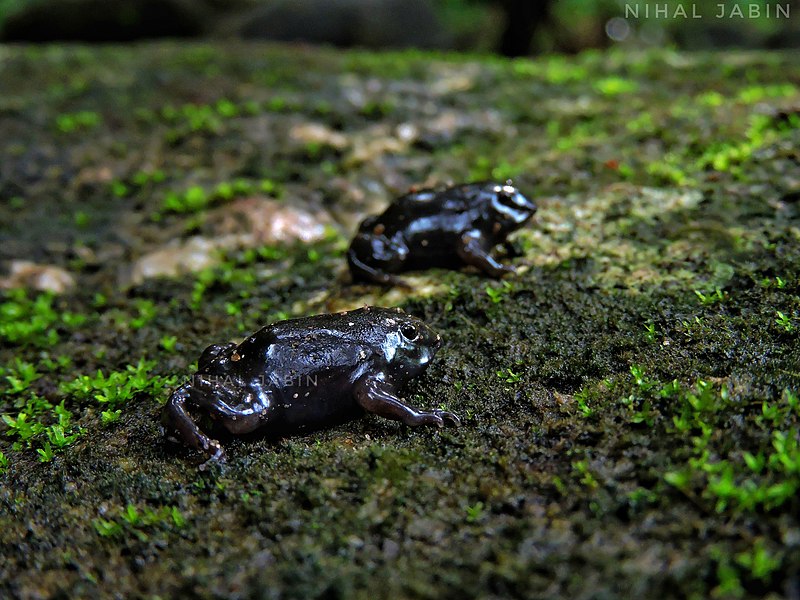
Purple Frog Facts
- Perhaps most notably, the clearly remarkable Purple Frog easily ranks as one of the most unusual lesser known amphibians in the entire world. That holds true, in large part, due to the very nature of its particular habitat. In this, it’s truly a unique creature.
- That’s because this amphibian actually spends the majority of its life underground. While many related species also dwell underground, few do so as extensively as this creature. Precisely why it took this evolutionary path, though, is unknown.
- The highly colorful creature received its descriptive common name due to the combined efforts of Biju & Bossuyt, respected Indian researchers. They accomplished the first recognition of the animal as a separate and distinct species in the year 2003.
- Sadly, however, this animal now finds itself facing multiple threats to its continued existence. Because of this truly lamentable fact, the IUCN currently lists the brilliantly colored amphibian as Endangered. That status appears on the organization’s Red List.
- The threats the Purple Frog faces, though, remain numerous. These further include the ongoing reduction and degradation of its already restricted range. The escalating effects of such factors as climate change also undermine its chances of survival.
Related Articles

Purple Frog Physical Description
The breathtaking Purple Frog understandably captures the attention and imagination of those fortunate enough to encounter to marvel. It typically does so, however, due to more to its startling pattern of coloring than size. That’s because it’s a small variety of frog.
In this respect, though, the amazing animal also follows a pattern of evolution shared by many of its kindred around the world. That’s in the fact that the remarkable amphibian displays a certain degree of the physiological characteristic of sexual dimorphism.
In its case, though, the males remain quite significantly smaller than the females. In fact, the larger females attain an average length measuring about 3.5 in (9 cm). Meanwhile, however, the males of the species rarely exceed 1.2 in (3 cm) in overall body length.
Both genders additionally display a decidedly horizontally swollen looking body shape. This provides a most unusual appearance. As a result of this characteristic, the animal has an overall flattened body form. It also develops a relatively small head with a pointed snout.
Its most remarkable physical feature, however, easily remains its unique coloring. That’s due to the fact that adults of the Purple Frog typically display a darker grayish-purple color. But the majority of younger individuals often display a deep, bright purple color.
- Kingdom: Animalia
- Phylum: Chordata
- Class: Amphibia
- Order: Anura
- Family: Nasikabatrachidae
- Genus: Nasikabatrachus
- Species: N. sahyadrensis
Purple Frog Distribution, Habitat, and Ecology
The stunning Purple Frog evolved as endemic to only a very limited section of the surface of the earth. That precise location for this zone of habitation, however, might surprise some of you. The natural marvel evolved as native to a very small section of the continent of Asia.
There, the moderately diminutive fauna inhabits a territorial range that consists of the majority of the Western Ghats, in the country of India, in Even this region of presence, however, currently represents an expansion of its previously supposed range of habitation.
The creature also inhabits every habitat type within the mountain range. This occurs due to the simple fact that the amphibian lives virtually its entire life underground. There, it feeds on a variety of insects, with its diet predominantly consisting of numerous termites.
In fact, the extremely reclusive animal only emerges from its underground habitat for a few days each year. This infrequent emergence occurs during the annual monsoon season. That’s because, at that time, instinct drives the amazing Purple Frog to the surface to mate.
Beyond these facts, however, researchers know very little of the biology of this species. Among the little known for certain is that males emerge near temporary streams formed by the torrential rains. After mating, eggs are laid in pools, usually among rocks.
Species Sharing Its Range
Check out our other articles on 4 Awesome Arthropods of Africa, Regal Birdflower, Shark Bay, Scottish Wildcat, Barreleye Fish, Bee Hummingbird, Japanese Spider Crab, Green Iguana
